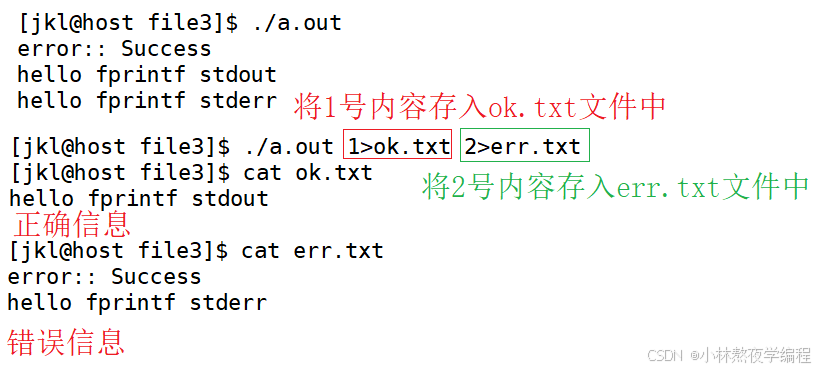✨个人主页: 熬夜学编程的小林
?系列专栏: 【C语言详解】 【数据结构详解】【C++详解】【Linux系统编程】
目录
1、封装简单的库
1.1、定义文件结构
1.2、打开文件
1.3、刷新缓冲区
1.4、写文件
1.5、关闭文件
1.6、各文件代码
2、stderr
2.1、C语言代码演示
2.2、C++代码演示
1、封装简单的库
1.1、定义文件结构
#define LINE_SIZE 1024#define FLUSH_NOW 1 // 立即刷新#define FLUSH_LINE 2 // 行刷新#define FLUSH_FULL 4 // 全缓冲typedef struct _myFILE { unsigned int flags;// 文件刷新方式 int fileno;// fd // 缓冲区 char cache[LINE_SIZE]; int cap;// 容量 int pos;// 下次写入的位置}myFILE;// C语言创建结构体变量需要加struct关键字,因此使用typedef重命名1.2、打开文件
打开文件本质是开辟一块存放文件数据的空间。
myFILE* my_fopen(const char* path,const char* flag){ int flag1 = 0;// 系统调用的文件打开方式 int iscreate = 0;// 文件是否被创建 mode_t mode = 0666;// 默认权限设置 // 读方式打开文件,只需设置flag1 if(strcmp(flag,"r") == 0) { flag1 = O_RDONLY; } // 写方式打开文件,设置flag1 和 iscreate else if(strcmp(flag,"w") == 0) { flag1 = (O_WRONLY | O_CREAT | O_TRUNC); iscreate = 1; } // 追加方式打开文件 else if(strcmp(flag,"a") == 0) { flag1 = (O_WRONLY | O_CREAT | O_APPEND); iscreate = 1; } else {} int fd = 0; if(iscreate) fd = open(path,flag1,mode);// 创建新文件权限限制才有效,传三个参数 else fd = open(path,flag1);// 打开已经存在的文件不会修改文件权限,使用两个参数即可 if(fd < 0) return NULL;// 打开文件失败返回NULL // 堆区开辟的空间出了函数不会销毁 myFILE* fp = (myFILE*)malloc(sizeof(myFILE)); if(fp == NULL) return NULL; fp->fileno = fd; fp->flags = FLUSH_LINE;// 设置行刷新 fp->cap = LINE_SIZE; fp->pos = 0; return fp;}1.3、刷新缓冲区
刷新缓冲区实质是将缓冲区内容写入需要刷新的文件中。
void my_fflush(myFILE* fp){ // 将缓冲区 pos 个字节的内容写入 fp 的文件中,并将pos置0 write(fp->fileno,fp->cache,fp->pos); fp->pos = 0;}1.4、写文件
写文件的本质是将内容拷贝到缓冲区中,条件允许就刷新缓冲区。
ssize_t my_fwrite(myFILE* fp,const char* data,int len){ // 写入的本质是拷贝,条件允许就刷新 memcpy(fp->cache + fp->pos ,data,len);// 需要考虑扩容与越界问题,此处不做处理,从简 fp->pos += len; // 刷新方式为行刷新且缓冲区遇到\n就刷新缓冲区 if((fp->flags & FLUSH_LINE) && fp->cache[fp->pos-1] == '\n') { my_fflush(fp); } return len; }1.5、关闭文件
先刷新缓冲区,在关闭文件并释放空间。
void my_fclose(myFILE* fp){ my_fflush(fp);// 刷新缓冲区 close(fp->fileno);// 关闭文件 free(fp);// 释放空间}1.6、各文件代码
mystdio.h
#pragma once #include <string.h>#include <stdlib.h>#include <sys/types.h>#include <sys/stat.h>#include <fcntl.h>#include <unistd.h>#define LINE_SIZE 1024#define FLUSH_NOW 1#define FLUSH_LINE 2#define FLUSH_FULL 4typedef struct _myFILE { unsigned int flags; int fileno; // 缓冲区 char cache[LINE_SIZE]; int cap;// 容量 int pos;// 下次写入的位置}myFILE;myFILE* my_fopen(const char* path,const char* flag);void my_fflush(myFILE* fp);ssize_t my_fwrite(myFILE* fp,const char* data,int len);void my_fclose(myFILE* fp);mystdio.c
#include "mystdio.h"myFILE* my_fopen(const char* path,const char* flag){ int flag1 = 0; int iscreate = 0; mode_t mode = 0666; if(strcmp(flag,"r") == 0) { flag1 = O_RDONLY; } else if(strcmp(flag,"w") == 0) { flag1 = (O_WRONLY | O_CREAT | O_TRUNC); iscreate = 1; } else if(strcmp(flag,"a") == 0) { flag1 = (O_WRONLY | O_CREAT | O_APPEND); iscreate = 1; } else {} int fd = 0; if(iscreate) fd = open(path,flag1,mode); else fd = open(path,flag1); if(fd < 0) return NULL; myFILE* fp = (myFILE*)malloc(sizeof(myFILE)); if(fp == NULL) return NULL; fp->fileno = fd; fp->flags = FLUSH_LINE; fp->cap = LINE_SIZE; fp->pos = 0; return fp;}void my_fflush(myFILE* fp){ write(fp->fileno,fp->cache,fp->pos); fp->pos = 0;}ssize_t my_fwrite(myFILE* fp,const char* data,int len){ // 写入的本质是拷贝,条件允许就刷新 memcpy(fp->cache + fp->pos ,data,len);// 考虑扩容与越界问题 fp->pos += len; if((fp->flags&FLUSH_LINE) && fp->cache[fp->pos-1] == '\n') { my_fflush(fp); } return len; }void my_fclose(myFILE* fp){ my_fflush(fp); close(fp->fileno); free(fp);}testfile.c
#include "mystdio.h"#include <stdio.h>#define FILENAME "log.txt"int main(){ // 使用自己封装的函数以写方式打开文件 myFILE* fp = my_fopen(FILENAME,"w"); if(fp == NULL) return 1; const char* str = "hello linux"; int cnt = 10; char buff[128]; while(cnt) { // 将格式化数据转成字符串到buff中 sprintf(buff,"%s - %d",str,cnt); // 将buff写入文件 my_fwrite(fp,buff,strlen(buff)); cnt--; sleep(1); my_fflush(fp);// 写完一组数据就刷新缓冲区 } my_fclose(fp);// 关闭文件 return 0;}运行结果

2、stderr
2.1、C语言代码演示
#include <stdio.h>int main(){ perror("error:"); fprintf(stdout,"hello fprintf stdout\n"); fprintf(stderr,"hello fprintf stderr\n"); return 0;}看现象
我们可以看到一部分数据存入了文件中,但是一部分数据没有存入文件中。

实质是 > 是标准输出重定向,修改1号fd里面的内容,其余的是2号fd里面的内容,因此直接打印到显示器上。
为什么有了标准输出流还要有标准错误流呢???
因为我们在编写程序的时候不能保证一直都是正确的代码,当我们查错误的时候就可以通过标准错误流查询。标准输出流主要用于程序的正常输出信息,标准错误流则用于输出程序的错误信息,两者共同确保了程序的运行状态可以被正确地监控和理解。
如果想让2和1都重定向到文件中怎么做?
1、将数据存入不同的文件
将1号的内容重定向到ok.txt 文件,将2号的内容存入err.txt文件。
命令行代码
[jkl@host file3]$ ./a.outerror:: Successhello fprintf stdouthello fprintf stderr[jkl@host file3]$ ./a.out 1>ok.txt 2>err.txt[jkl@host file3]$ cat ok.txthello fprintf stdout[jkl@host file3]$ cat err.txterror:: Successhello fprintf stderr运行结果

2、将数据存入同一个文件
命令行代码
[jkl@host file3]$ ./a.out 1>all.txt 2>&1[jkl@host file3]$ cat all.txterror:: Successhello fprintf stderrhello fprintf stdout运行结果

总结
perror("open");本质是向2号打印。printf("");本质是向1号打印。2.2、C++代码演示
#include <iostream>int main(){ std::cout<<"hello cout"<<std::endl; std::cerr<<"hello cerr"<<std::endl; return 0;}命令行代码
[jkl@host file3]$ g++ test_stderr.cpp[jkl@host file3]$ ./a.out hello couthello cerr[jkl@host file3]$ ./a.out > log.txthello cerr[jkl@host file3]$ cat log.txthello cout运行结果
